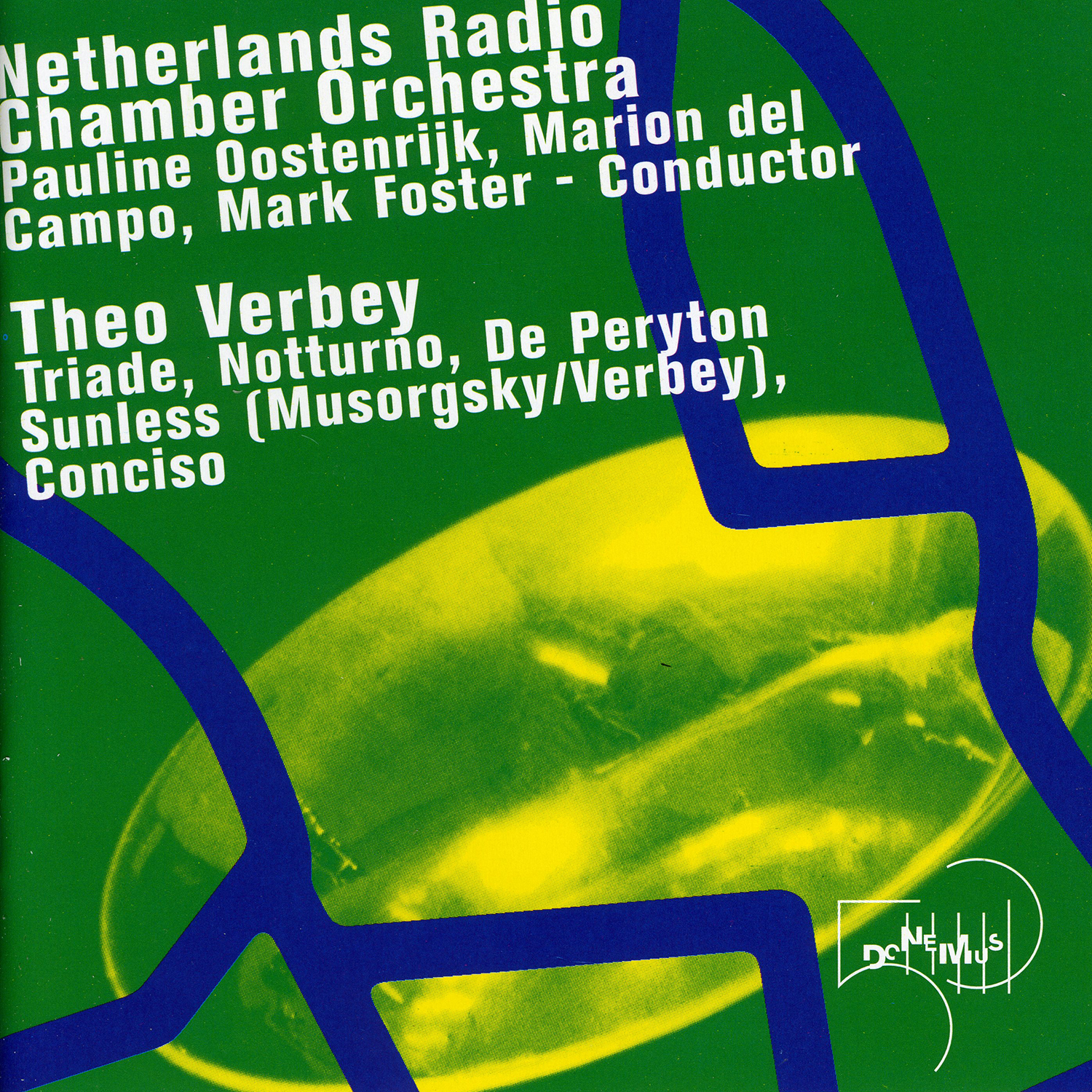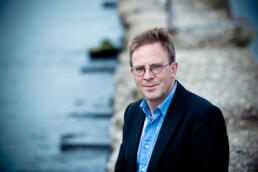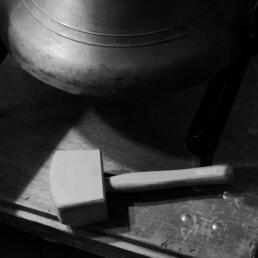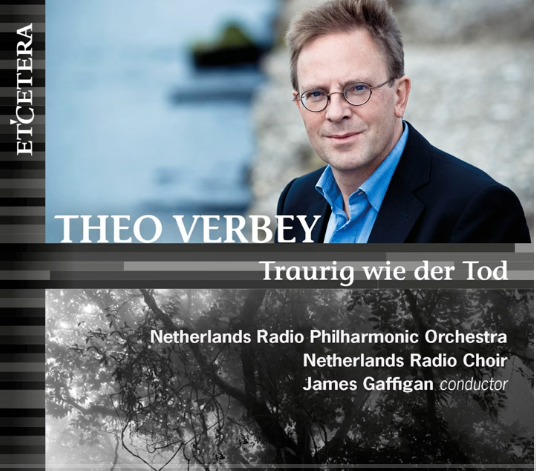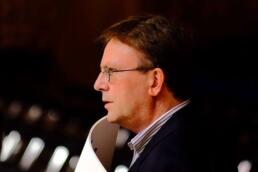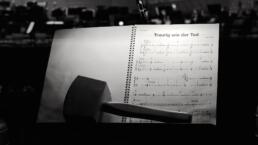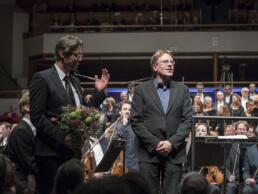Mussorgsky: Une Larme
Details
Duration:
5'
Instrumentation:
string orchestra
First performed:
Amsterdam Sinfonietta
Ravel – Trois Chansons: Oiseaux Tristes, La Vallee des Cloches, La Valse
Ravel – Trois Chansons: Oiseaux Tristes, La Vallee des Cloches, La Valse
Inst. Theo Verbey | 1990
The Simorq
Details
Duration:
12'
Instrumentation:
1.0.2.0 - 1.0.0.0 - vibr, hp, pf, 2vn, va, vc, cb
Ouverture (Suite) in G
Ouverture (Suite) in G
2000
Details
Instrumentation:
0. 2.0.1. – hps, bc, str
Can also be performed as part of the suite called “Orchesterübung,” together with Verbey’s arrangement of Bach’s Italian Concerto in G BWV 971 for solo violin, strings and continuo, Bach’s Ouverture in the French Style BWV 831 and the Ouverture (Suite) in D in the style of Bach, written by Verbey after BWV 1068.
In Theo's Own Words
“Back in the early 1990s I began working on an instrumentation of Bach’s Ouvertüre nach französische Art (B minor Partita) BWV 831 for transverse flute, strings and continuo. I had a strong urge to do this when, after having written a few Bach fugues while majoring in Music Theory, I then wanted to delve further into the harmonic / instrumental counterpoint of Bach with a view to specializing in the methodology of teaching counterpoint. The remarkable thing about the two keyboard works in the second part of the Clavierübung (1735) is that they actually appear to be two keyboard transcriptions of orchestral works. At that time, the need for purely orchestral music was of course extremely limited, and music that had no practical purpose was simply not composed. At the beginning of April 2000, when it became clear that no living composer would be taking part in commemorating the two-hundred-and-fiftieth anniversary of the death of the greatest composer of all time, I decided to return to and complete my arrangement of the Overture BWV 831 for transverse flute, strings and continuo. The problems I had run up against in the early 1990s mainly revolved around Bach’s treatment of dissonance and parallelism in his contrapuntal writing circa 1730. After re-analyzing the four Ouvertüren (BWV 1066-1069), the following books in particular helped me a great deal in my writing:
- Laurence Dreyfus: – Bach and the patterns of invention (1996) – Bach’s Continuo Group (1987)
- Jesper Bøje Christensen: – Die Grundlagen des Generalbaßspiels in 18. Jahrhundert (1992)
- Dietrich Bartel: – Handbuch der musikalische Figurenlehre (1997)
- Alfred Mann: – The Study of the Fugue (1987)
- Robert L. Marshall: – The Music of Johann Sebastian Bach (1989)
- and especially Philipp Spitta – Johann Sebastian Bach (Part III, Appendix XII), which contains Bach’s own rules for playing the continuo.
French counterpoint books, such as those of Gedalge (1901), Dupré (1938) and Koechlin (1926), proved of little use, despite their charm. My attempt seemed to have turned out not too unsatisfactorily. And, since completing the exercise made me hungry for more, I went on to write two Ouvertures in the style of Bach, in May and June of 2000, after BWV 1066 and BWV 1068 respectively. Finally, in July 2000, I rewrote the Konzert im Italienischen gusto as a Concerto for violin solo, strings and continuo, and decided to give the whole piece—consisting of four orchestral works—the title Orchesterübung, with a nod to the Clavierübung.”
– Theo Verbey
Ouverture (Suite) in D
Ouverture (Suite) in D
2000
Details
Instrumentation:
0. 2.0.1. – hps, bc, str
Can also be performed as part of the suite called “Orchesterübung,” together with Verbey’s arrangement of Bach’s Italian Concerto in G BWV 971 for solo violin, strings and continuo, Bach’s Ouverture in the French Style BWV 831 and the Ouverture (Suite) in G in the style of Bach, written by Verbey, after BWV 1066.
In Theo's Own Words
“Back in the early 1990s I began working on an instrumentation of Bach’s Ouvertüre nach französische Art (B minor Partita) BWV 831 for transverse flute, strings and continuo. I had a strong urge to do this when, after having written a few Bach fugues while majoring in Music Theory, I then wanted to delve further into the harmonic / instrumental counterpoint of Bach with a view to specializing in the methodology of teaching counterpoint. The remarkable thing about the two keyboard works in the second part of the Clavierübung (1735) is that they actually appear to be two keyboard transcriptions of orchestral works. At that time, the need for purely orchestral music was of course extremely limited, and music that had no practical purpose was simply not composed. At the beginning of April 2000, when it became clear that no living composer would be taking part in commemorating the two-hundred-and-fiftieth anniversary of the death of the greatest composer of all time, I decided to return to and complete my arrangement of the Overture BWV 831 for transverse flute, strings and continuo. The problems I had run up against in the early 1990s mainly revolved around Bach’s treatment of dissonance and parallelism in his contrapuntal writing circa 1730. After re-analyzing the four Ouvertüren (BWV 1066-1069), the following books in particular helped me a great deal in my writing:
- Laurence Dreyfus: – Bach and the patterns of invention (1996) – Bach’s Continuo Group (1987)
- Jesper Bøje Christensen: – Die Grundlagen des Generalbaßspiels in 18. Jahrhundert (1992)
- Dietrich Bartel: – Handbuch der musikalische Figurenlehre (1997)
- Alfred Mann: – The Study of the Fugue (1987)
- Robert L. Marshall: – The Music of Johann Sebastian Bach (1989)
- and especially Philipp Spitta – Johann Sebastian Bach (Part III, Appendix XII), which contains Bach’s own rules for playing the continuo.
French counterpoint books, such as those of Gedalge (1901), Dupré (1938) and Koechlin (1926), proved of little use, despite their charm. My attempt seemed to have turned out not too unsatisfactorily. And, since completing the exercise made me hungry for more, I went on to write two Ouvertures in the style of Bach, in May and June of 2000, after BWV 1066 and BWV 1068 respectively. Finally, in July 2000, I rewrote the Konzert im Italienischen gusto as a Concerto for violin solo, strings and continuo, and decided to give the whole piece—consisting of four orchestral works—the title Orchesterübung, with a nod to the Clavierübung.”
– Theo Verbey
Triade
Details
Duration:
20'
Instrumentation:
2.2.2.2 - 2.0.0.0 - perc, hp, str(6.6.4.4.2)
Commissioned by:
Performing Arts Fund NL
Dedicated to:
Nieuw Sinfonietta Amsterdam
Find on CD:
In Theo's Own Words
“I try to compose a kind of music that is influenced almost to a point of saturation: not by a mere fifty years of tradition, but by hundreds of years. Everyone knows that 1914, the moment that the musical world exploded, is more or less the most significant moment of this century. But the further away we are from that moment, the more space we find on the other side of the looking-glass.”
– Theo Verbey
Triade also has a strong connection with the musical tradition in general and with Mozart’s Symphony No.38, K504 (the Prague) in particular. The structural framework, the length, proportions and the technical ideas in this symphony form the basis on which Verbey builds his own composition. However, Verbey doesn’t use style imitations as Stravinsky did in Pulcinella, nor does he use the romantic form structures Schoenberg used is his later works, nor does he quote literally from the musical tradition as Luciano Berio did in his famous Sinfonia. By abstracting the technical ideas from the Mozart symphony (in this case, the development of a seemingly unimportant small motif to become the leading thematic role) Verbey explores the relationship between principal theme and accompaniment and draws the listener’s attention to this role-swapping element, using it for his own composition. Thus, in Triade Verbey does not imitate the melodies or harmonies of Mozart’s Prague Symphony, but constructs a composition based on its phrasing and structural proportions, as well as the relationships between harmonies and melodies. The work would be unthinkable if it were not for Mozart, but not for a moment does it sound like him. To quote Verbey again: “the idea of borrowing models from the past and using them in slightly different ways to produce something really new I find very special”. The piece shows that a healthy respect for tradition need not result in imitation, but is rather a catalyst for thought and reconsideration, for a critical but positive stance. As with the Mozart, Verbey’s Triade is written in D major. The title refers to the three movements of the composition and the tripartite form of these movements.
In Concert
22 Jan 2010
Traurig wie der Tod
Traurig wie der Tod
2014-2015
Details
Duration:
20'
Instrumentation:
2.2.2.4 - 4.2.2.3.1- timp, 3perc[1.Tenor Drum, Tamtam, Triangle 2. Bass Drum 3. 2 Bells in C and G, behind the scene (These bells are the same as in the Symphony Fantastique by Hector Berlioz) - 2hp - str(16.14.12.10.8) Large Mixed Choir SATB
Based on texts by:
Hans Bethge
Commissioned by:
AVROTROS Vrijdagconcert
World premiere:
The Netherlands Radio Choir, the Netherlands Radio Philharmonic Orchestra and conductor James Gaffigan in Utrecht TivoliVredenburg, Utrecht on 29 May 2015
Find on CD:
In Theo's Own Words
“I had been planning for some years to compose a piece for large chorus and orchestra – I had visions of an ‘enormous space in sound’ and a work of considerable duration.
In 2014, the chance arrived. The original title was Elysium: the residence of the Greek gods after their earthly life. When the moment came to actually turn my plans into deeds (the summer of 2014) I seemed to have changed my mind. Profound events such as the deterioration of the health of my mother, but also the disaster involving flight MH17 above Ukraine, were enough reason for me to throw away all the sketches I’d made up to that moment and to begin again. In Die Chinesische Flöte (1907) by Hans Bethge (1876-1946), I found poems that were more in sync with my new plans. The poems are characterized by simple metaphors and especially by a sombre content. I have chosen five poems which fit within the layout of a connected cycle. These are German reinterpretations of ancient Chinese poems by very diverse poets.
In the end, composing the piece took up approximately half a year. The result, Traurig wie der Tod, is a song cycle consisting of five songs alternating with instrumental interludes, which eulogizes sorrow from various perspectives.
In the first song, Mond und Menschen, a sharp distinction is made between the image of nature as stable and unchanging, compared with human beings as being confused and restless. At the end of this song the music accelerates and leads to the first orchestral interlude. The second song, Die Einsame, is about the sorrow and pain of someone who is not near her loved one. After an orchestral eruption, the third song Eine Junger Dichter denkt an die Geliebte is brought back to one stanza in an extremely contrasting idiom. After yet another orchestral interruption, the fourth and fifth songs follow each other directly. The fourth song, Verzweiflung, is a reflection of the second. It’s about the sorrow of tedium in confinement. The fifth song, Das Los des Menschen, has the singularity of our existence as its subject. Existence is like a sigh of the wind and the result of life is like a grave on which weeds grow. The first song is reflected here, both in the text and the music.
The resulting structure of the piece is a palindrome: ABCBA. This applies as well to the musical style: the style of the first song uses the techniques of the twentieth century. Afterwards there’s an abrupt modulation back to the 19th century, in order to end up in an archaic musical form from the early 18th century. Then the route is followed in the opposite direction. “
– Theo Verbey
In Concert
29 May 2015
28 May 2015
Video
Recording
Interview
Theo Verbey on Traurig wie der Tod: ‘A composer is primarily a songwriter’
Photo
Bethge poems Traurig_plus translation_English
Original poems in German and translated into English.
Tractus
Details
Duration:
10'26"
Instrumentation:
0000 0000 harm cimb str(6.6.4.4.2.)
Commissioned by:
Performing Arts Fund+ NL and Amsterdam Sinfonietta
In Theo's Own Words
“Tractus is originally the name of one of the Gregorian chants. In the Middle Ages, the tractus repertoire grew considerably and was seen as a form of lamentation. In my composition for cimbalom, harmonium and 22 strings, I have used the tractus Exáudi me from Feria III post Diminicam Septuagesimae, but just the first section of it. The lament itself is only heard at the beginning and at the end of the piece. By using a system of what’s known as metric modulation, the slow initial tempo is first doubled, and then tripled, before finally returning to the slow tempo of the beginning.
In addition, I have adopted something of the tractus’s church mode: the so-called hypodoric, but again, only at the beginning and the end. Most of the time, however, there are a limited number of chords, which are usually repeated in a fixed order.
In addition to the string orchestra, the piece consists of cimbalom and harmonium. I got the idea of using these two instruments while completing the 1919 version of Igor Stravinsky’s Les Noces, which I worked on in late 2007 / early 2008. The instrumentation of that version consists of piano, 2 cimbaloms, harmonium and percussion. The cimbalom is mainly used to indicate tempo and meter, so the piece could be played without a conductor. The harmonium is used to color the sound of the string orchestra and, in a way, to distort it.”
– Theo Verbey
In Concert
02 May 2009
